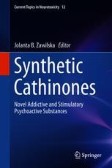Search
Search Results
-
Four Synthetic Cathinones: 3-Chloromethcathinone, 4-Chloromethcathinone, 4-Fluoro-α-Pyrrolidinopentiophenone, and 4-Methoxy-α-Pyrrolidinopentiophenone Produce Changes in the Spontaneous Locomotor Activity and Motor Performance in Mice with Varied Profiles
Two chloromethcathinones, 3-chloromethcathinone (3-CMC) and 4-chloromethcathinone (4-CMC), and two para -substituted α-pyrrolidinophenones,...

-
Cytotoxicity of α-Pyrrolidinophenones: an Impact of α-Aliphatic Side-chain Length and Changes in the Plasma Membrane Fluidity
Pyrovalerone derivatives (α-pyrrolidinophenones) form a branch of synthetic cathinones, a second most prominent group of novel psychoactive...

-
Acute Intoxications Involving α-Pyrrolidinobutiophenone (α-PBP): Results from the Swedish STRIDA Project
IntroductionMany new psychoactive substances (NPS) introduced as recreational drugs have been associated with severe intoxication and death.
...
-
Synthetic Cathinones: Neurotoxic Health Hazards and Potential for Abuse
Synthetic cathinonesSynthetic cathinones (SCs) represent an alternative to the prevailing array of drugs of abuse, with this being attributable to...
-
Cytotoxic Activity of Pyrovalerone Derivatives, an Emerging Group of Psychostimulant Designer Cathinones
The growing popularity of novel psychoactive substances (NPS) has aroused the concerns of public health specialists. The pyrovalerone derivatives are...

-
Synthetic Cathinones—Prevalence and Motivations for Use
This chapter considers the prevalencePrevalence of and motivationsMotivations for use of synthetic cathinonesSynthetic cathinones . As part of the...
-
New psychoactive substances: an overview on recent publications on their toxicodynamics and toxicokinetics
This review article covers English-written and PubMed-listed review articles and original studies published between January 2015 and April 2016...

-
Structure-Activity Relationships of Synthetic Cathinones
Until recently, there was rather little interest in the structure-activity relationships (SARs) of cathinone analogs because so few agents were...
-
In vitro cytochrome P450 inhibition potential of methylenedioxy-derived designer drugs studied with a two-cocktail approach
In vitro cytochrome P450 (CYP) inhibition assays are common approaches for testing the inhibition potential of drugs for predicting potential...

